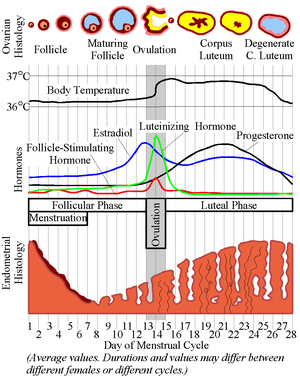Kareseban: Béda antarrépisi
| Baris ka-17: | Baris ka-17: | ||
===Fase folikulér=== |
===Fase folikulér=== |
||
<!-- |
<!--Alatan pangaruh ningkatna [[hormon stimulasi folikel]](''Follicle stimulating hormone'', FSH), five to seven tertiary-stage ovarian follicles are recruited for entry into the menstrual cycle. These follicles, that have been growing for the better part of a year in a process known as [[folliculogenesis]], compete with each other for dominance. In a signal cascade kicked off by [[luteinizing hormone]] (LH), the follicles secrete [[estradiol]], a steroid that acts to inhibit pituitary secretion of FSH. With diminished FSH supply comes a slowing in growth that eventually leads to follicle death, known as ''atresia''. The largest follicle secretes [[inhibin]] that serves as a finishing blow to less competent follicles by further suppressing FSH. This ''dominant follicle'' continues growing, forms a bulge near the surface of the ovary, and soon becomes competent to ovulate. |
||
The follicles also secrete [[estrogen]]s (of which estradiol is a member). Estrogens initiate the formation of a new layer of endometrium in the uterus, histologically identified as the proliferative endometrium. If fertilised, the [[embryo]] will implant itself within this hospitable flesh.--> |
The follicles also secrete [[estrogen]]s (of which estradiol is a member). Estrogens initiate the formation of a new layer of endometrium in the uterus, histologically identified as the proliferative endometrium. If fertilised, the [[embryo]] will implant itself within this hospitable flesh.--> |
||
Révisi nurutkeun 26 Maret 2006 12.13

Kareseban mangrupakeun kaayaan fisiologis normal awéwé [1] dina siklus kareseban nu lumangsung sababaraha poé (ilaharna mah 3-5 poé) nu patali jeung kasuburan/fértilitas réproduktifna, ditandaan ku kaluarna getih (eumenorrhea, 10-18 ml, rata-rata 35 ml[2]); para wanoja sabagian bisa ngawaskeun kaluarna jaringan éndométrium pacampur getih nu kaluar nalika kareseban. Getih nu kaluar ieu teu ngagumpal kusabab éndométrium ngaluarkeun énzim nu disebut plasmin.
Kusabab kaleungitan getih nalika kareseban, wanoja butuh asupan zat beusi dina katuanganana leuwih loba batan lalaki sangkan teu ngalaman defisiénsi beusi. Nalika kareseban, aya ogé nu sok ngalaman keram (katelah dysmenorrhea).
Artikel ieu museur kana siklus kareseban nu lumangsung di manusa.
Sari
Nu bener-bener ngalaman siklus kareseban mah ukur manusa jeung kera gedé, mamalia plaséntal lianna mah lolobana ukur ngalaman éstrus. Siklus kareseban diatur ku sistim hormon réproduksi nu diperlukeun pikeun baranahan, sacara umum lumangsung bulanan ti saprak pubertas nepi ka ménopause.
Dina awal siklus kareseban, wanoja nu geus sawawa sacara séksual ngaleupaskeun hiji ovum (atawa, kadang-kadang, dua, nu bisa ngahasilkeun kembar dizigotik atawa non-idéntik) nalika ovulasi. Sanggeus ovulasi, lapisan éndométrium rahim robah pikeun nyiapkeun kamungkinan implantasi ovum nu geus dibuahan pikeun ngamimitian kakandungan. Mun teu aya fértilisasi sarta teu reuneuh, rahim ngaleupaskeun lapisan éndométrium pikeun nyiapkeun siklus salajengna. Prosés ngaleupaskeun lapisan éndométrium ieu nu disebut kareseban, kaluarna éndométrium jeung getih ngaliwatan heunceut. Najan sacara umum dianggap getih, kandunganana mah béda ti getih véna.
Kareseban mangrupakeun tanda yén hiji wanoja teu kakandungan (najan kitu, kadang aya ogé nu ngalamana kaluarna saeutik getih nalika awal kakandungan), ku kituna, telat kareseban dina masa subur mangrupakeun totondén awal kakandungan. Rata-rata wanoja mimiti ngalaman kareseban dina umur 12 taun, antara 8 jeung 16 taun[3]. Siklus kareseban ieu lumangsung nepi ka mangsa ménopause, kira nalika nincak umur 45-55. Simpangan tina pola ieu perlu dipariksakeun ka dokter; misalna amenorrhea, tayana kareseban dina mangsa nu leuwih lila, tapi teu kakadungan. Gangguan sarupa kieu kadang kaalaman ku wanoja nu kandungan lemak awakna leutik, samodél atlit.
Siklus kareseban normal
Siklus kareseban téh rupa-rupa panjang waktuna, ogé dina unggal sato. Wanoja mah rata-rata siklus karesebanana salila 28 poé, nu kabagi kana opat fase: kareseban, fase folikulér, ovulasi, jeung fase lutéal.
Fase folikulér
Ovulasi
Fase lutéal
Abnormalitas siklus
Rujukan
- Menstrual cycle, Wikipédia édisi basa Inggris (26 Maret 2006)
- K. Stern and M. K. McClintock: "Regulation of ovulation by human pheromones." Nature, 392 (1998), pages 177 – 179.
- Gangestad et al.: "Women's preferences for male behavioral displays change across the menstrual cycle." Psychological Science, March 2004, vol. 15, no. 3, pages 203 - 207
- Maguire, J.L. . . . and I. Mody. (2005). "Ovarian cycle-linked changes in GABAA receptors mediating tonic inhibition alter seizure susceptibility and anxiety". Nature Neuroscience 8 (June): 797-804.
Catetan
- ^ "At what age does a girl get her first period?," from Menstruation and the Menstrual Cycle, National Women's Health Information Center (accessed June 11, 2005).
- ^ Ibid., "What is a typical menstrual period like?" (accessed June 11, 2005).
- ^ "Lower olfactory threshold during the ovulatory phase of the menstrual cycle" by E. Navarrete-Palacios, R. Hudson, G. Reyes-Guerrero and R. Guevara-Guzman in Biol Psychol. (2003) volume 63 page 269-279 PMID 12853171
- ^ M. Ball, "A prospective field trial of the Ovulation Method", European Journal of Obstetrical and Gynaecological Reproductive Biology, 6/2, 63-6, 1976. (Summarized at Trials of the Billings Ovulation Method accessed November 3, 2005)
- ^ "Medical Microbiology" 4th ed. Online textbook Samule Baron, editor. (1996) Published by University of Texas Medical Branch; Galveston (TX)
Tumbu kaluar
- Museum of Menstruation and Women's Health
- Leslie Botha-Williams, Women's Health Educator: A Woman's Guide to Understanding Her Hormone Cycle, http://www.holyhormones.com
- An Islamic answer for the ruling of women menstruating
- Menstrual Suppression With Birth Control Pills
- On The Rag: Everything you need to know about your fertility cycles and menstruation...period - Article on the menstrual cycle by notable sex activist and educator Heather Corinna
- Menstral - menstrual calendar for your mobile phone
Produk higienis
- Love Your Blood: An info-zine on menstrual products and their alternatives
- The rags: paraphernalia of menstruation
- Eight Myths About Washable Menstrual Pads Dispelled
- Tampaction and The Bloodsisters Project- Menstrual activism against chlorine bleaching, excessive packaging, and negative attitudes toward menstruation in the West
| Artikel ieu mangrupa taratas, perlu disampurnakeun. Upami sadérék uninga langkung paos perkawis ieu, dihaturan kanggo ngalengkepan. |

